Beijing says Hong Kong protests 'show signs of terrorism.' If you only watch state media, you probably agree

Hong Kong (CNN)Out-of-control mobs beating up police. Crazed separatists throwing petrol bombs and vandalizing government buildings. The symbols of the country insulted and humiliated. Local authorities overwhelmed and in need of assistance.
This is the picture consumers of Chinese state media have been receiving of the Hong Kong protests, now approaching their 11th consecutive weekend. While there is some truth to it -- there have been numerous incidents of violence, and protesters have targeted Chinese flags and government buildings -- it remains a highly selective and incomplete take.
Crucially, it appears to distort the reasons behind the unrest. Protests were initially sparked by opposition to a now-shelved extradition bill, but have since expanded to include demands for an investigation into police brutality and long-running calls for greater democracy and political reform.
It also ignores the many peaceful marches and the reciprocal, seemingly self-perpetuating cycle of violence, with both protesters and police deploying increasingly forceful tactics.
While many Hong Kongers are concerned about the escalating violence, and many have been inconvenienced by transport shutdowns and other travel disruptions, there is little sense of danger in the city beyond the protest front lines, and it is certainly far from the war zone often depicted in Chinese state media.
The presentation of the protests in mainland China -- where propaganda combines with the vast online censorship apparatus of the Great Firewall to allow the government to construct a narrative of its choosing -- has evolved significantly over the past two months.

Police use pepper spray to disperse protesters at the Hong Kong International Airport on Tuesday, August 13. For the second day in a row, protesters flooded the airport. Check-ins were suspended and dozens of outgoing flights were canceled.

Police and protesters clash at the airport on August 13. The violence came after Hong Kong's Airport Authority announced that all check-in services would be suspended for another night because of terminal operations being "seriously disrupted."

A traveler passes her luggage to security guards as she tries to enter the departures gate.
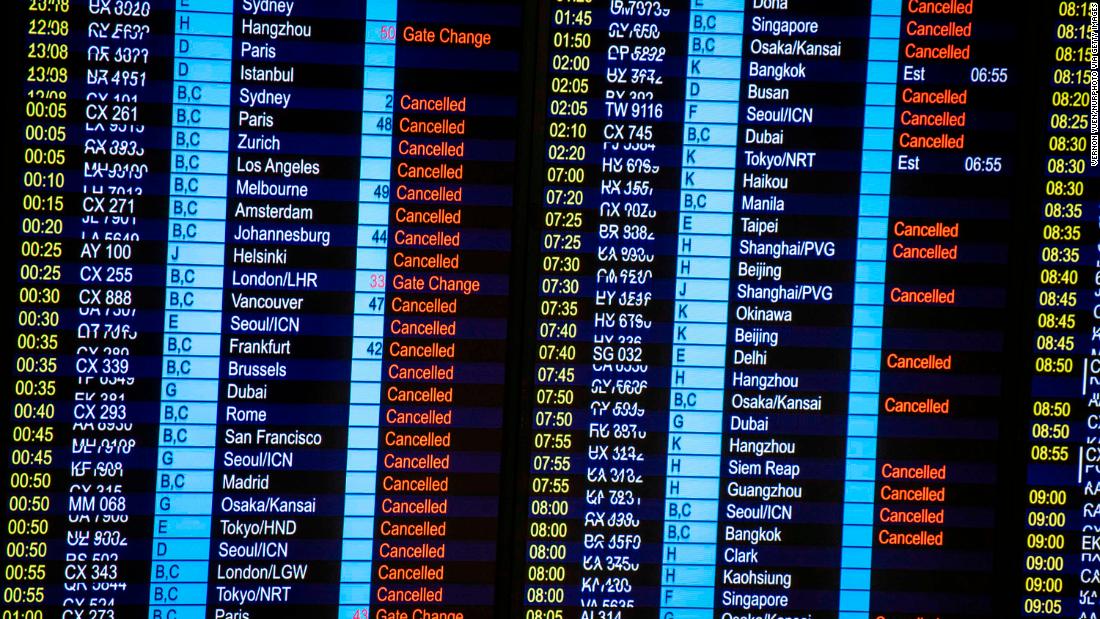
A display board shows canceled flights on August 13.

Anti-government protesters stand at a barricade made of luggage trolleys during a demonstration at the airport on August 13.

A woman wearing Minnie Mouse headgear looks on as stranded travelers gather near closed check-in counters on August 13.

Protesters display banners during a sit-in rally at the airport's arrival hall on Monday, August 12.

People hold signs during airport protests on August 12. The signs reference a woman who was shot in the eye with a beanbag round during clashes between protesters and police.

Medics look after a woman who received a facial injury during clashes on Sunday, August 11.
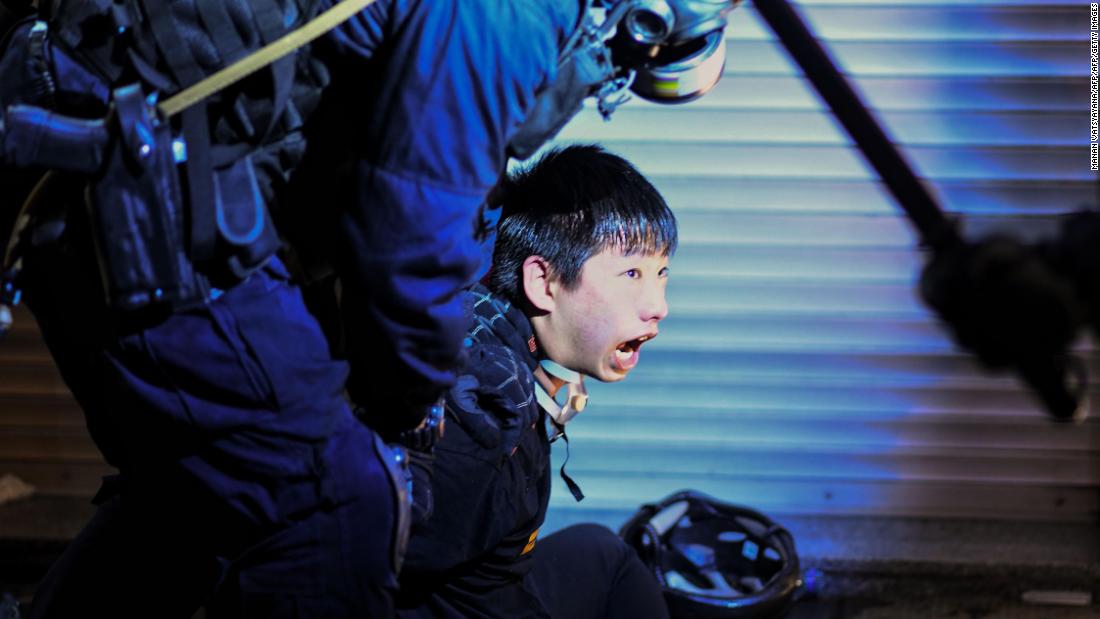
A pro-democracy protester is held by police outside the Tsim Sha Tsui police station on August 11.

A "Lennon wall" featuring a raincoat is plastered with sticky notes on Saturday, August 10.

Police fire tear gas at protesters during a demonstration in the Wong Tai Sin District on Monday, August 5.

A train passenger gestures toward a protester, right, who was preventing the doors of a train from closing on August 5. The protester was trying to disrupt Hong Kong's morning rush-hour commute.

A man lies down on an underground train during a protest on August 5.
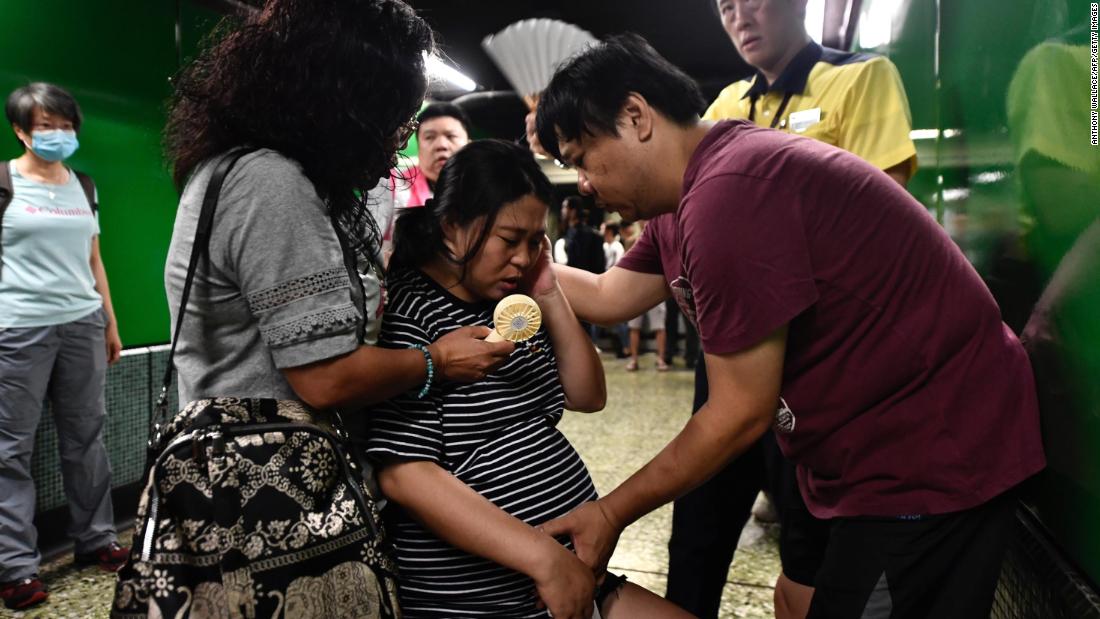
A man comforts his pregnant wife near a train platform after protesters blocked the train doors on August 5.

A protester stands in tear gas during a confrontation with police in the early hours of Sunday, August 4.

A Chinese flag floats in water after it was thrown by protesters during a demonstration on Saturday, August 3.

A protester sprays paint on a wall on August 3.
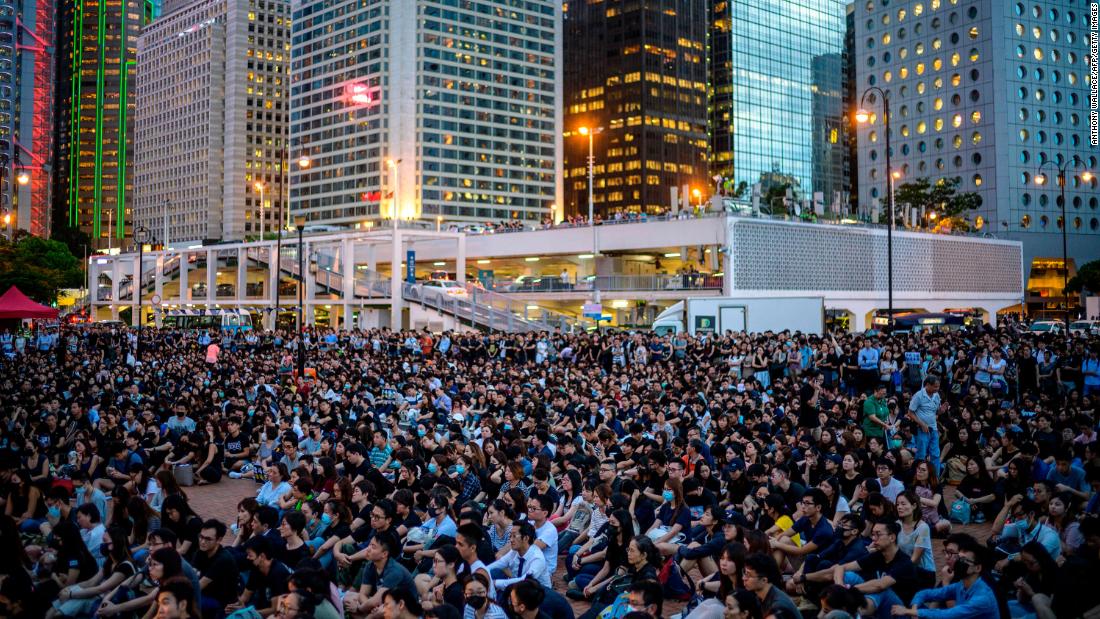
Members of Hong Kong's medical sector attend a protest in Edinburgh Place on Friday, August 2.

The emblem on the China Liaison Office is protected by plexiglass during a demonstration on Sunday, July 28.

A protester flees from baton-wielding police in the Yuen Long district of Hong Kong on Saturday, July 27.

A protester looks through umbrellas during the clashes with police on July 27.

Travelers watch as protesters rally at Hong Kong's international airport on Friday, July 26.

People paste Post-it notes on a demonstrator in the Hong Kong airport.

Protesters clash with police on Sunday, July 21.

Masked men in white T-shirts are seen after attacking anti-extradition bill demonstrators at a train station in Yuen Long.

Police fire tear gas at protesters during a march on July 21.
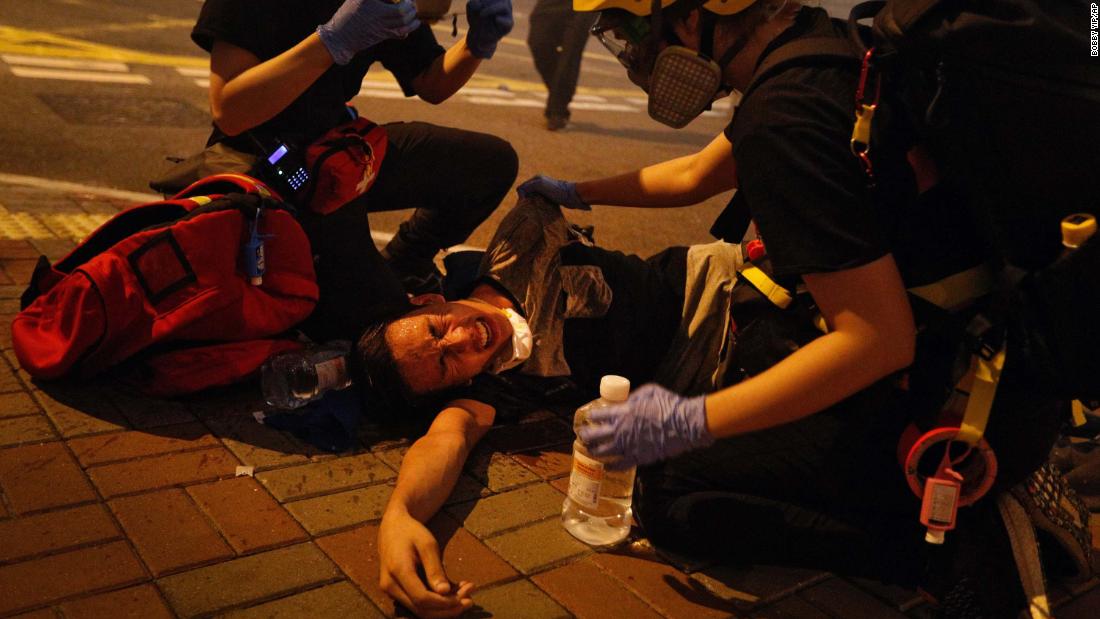
Medical workers help a protester affected by tear gas on July 21.

An egg thrown by a protester hits the emblem on the China Liaison Office on July 21.
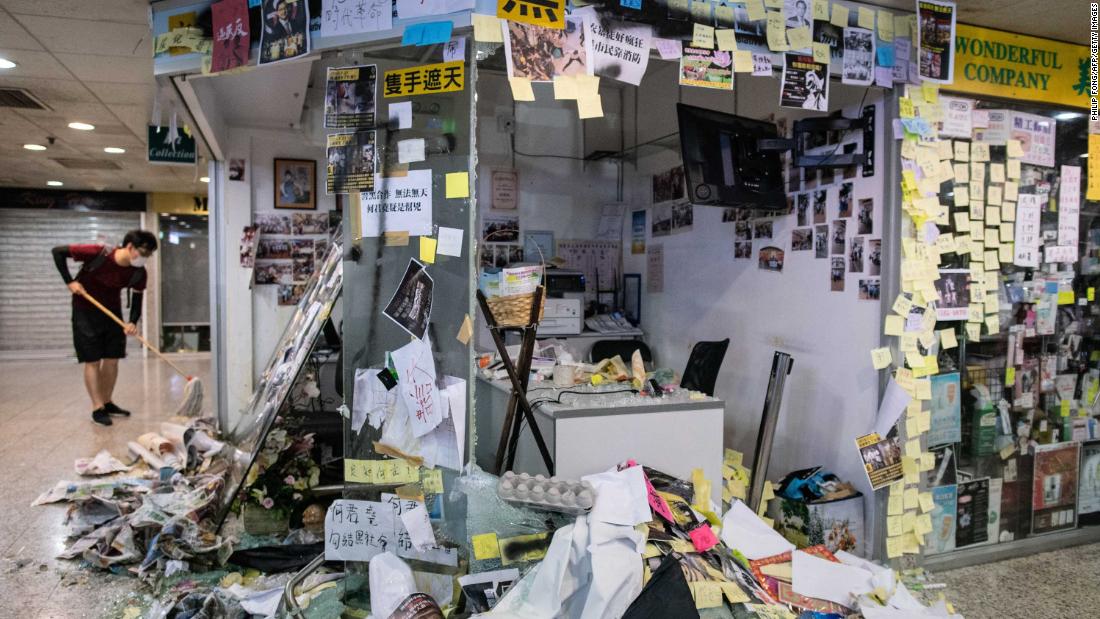
The office of pro-Beijing lawmaker Junius Ho was trashed by protesters in Hong Kong's Tsuen Wan district.

A protester covers a security camera outside the Chinese government's liaison office in Hong Kong.

Protesters gather for a demonstration on July 21.

Police officers use pepper spray to disperse protesters after a rally in the Sheung Shui district on Saturday, July 13.
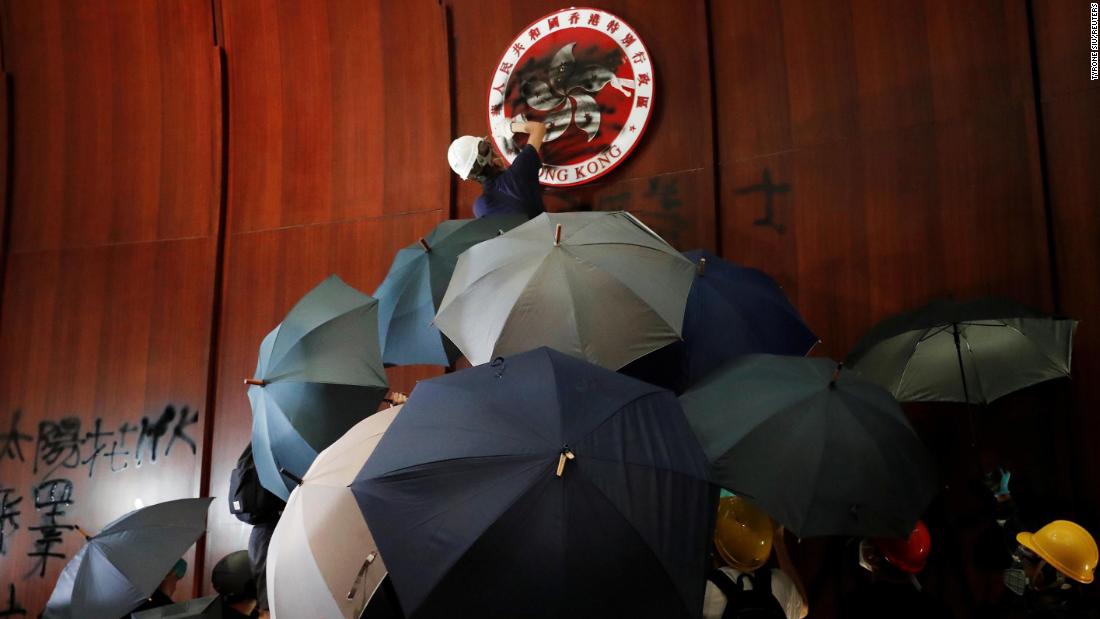
A demonstrator sprays paint inside a chamber at Hong Kong's Legislative Council building, where protesters forced their way in on Monday, July 1.

The meeting hall of the Legislative Council is taken over by demonstrators on July 1.

A protester uses a megaphone to speak to other protesters inside the Legislative Council building.

Protesters stream into the Legislative Council building.

A protester smashes a window of the Legislative Council building.

Protesters holding umbrellas face off with police officers wearing anti-riot gear on July 1.

Police standing inside the Hong Kong government headquarters look through broken glass as protesters try to smash their way into the building on July 1.

Columns of sunlight are cast on a crowd during the march on July 1.

Helicopters carrying the flags of China and Hong Kong fly over demonstrators on July 1.

Pro-democracy lawmaker Roy Kwong rallies demonstrators with a megaphone on July 1.

A protester holds up a placard as thousands flood the streets of Hong Kong on July 1.
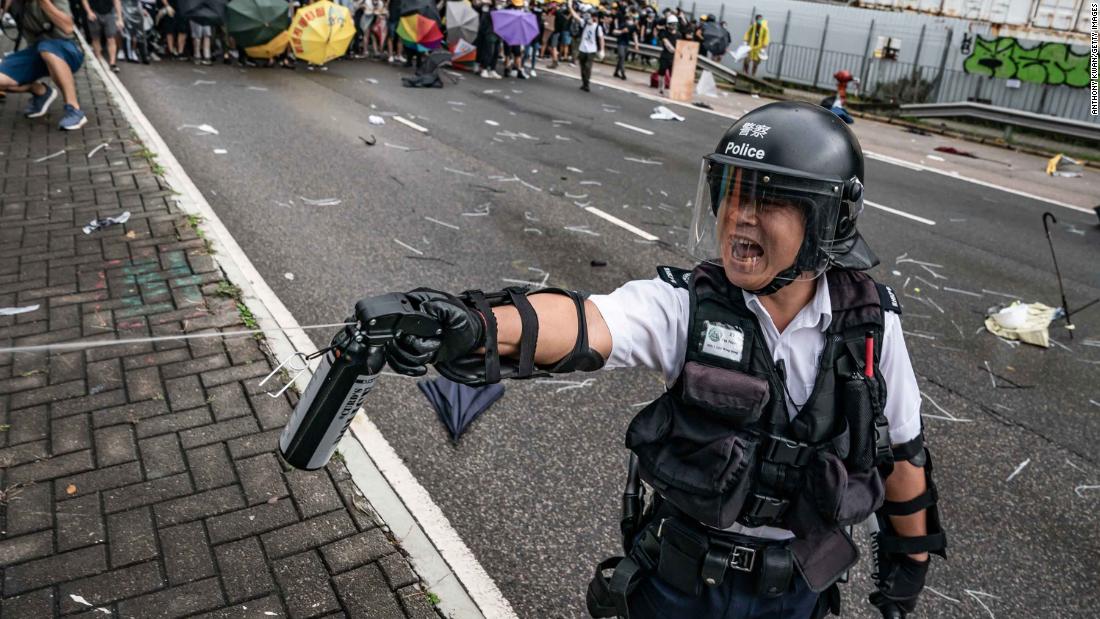
A police officer uses pepper spray during a clash with protesters on July 1.

Protesters face police on July 1.

Protesters remove their shirts after being pepper-sprayed by police.
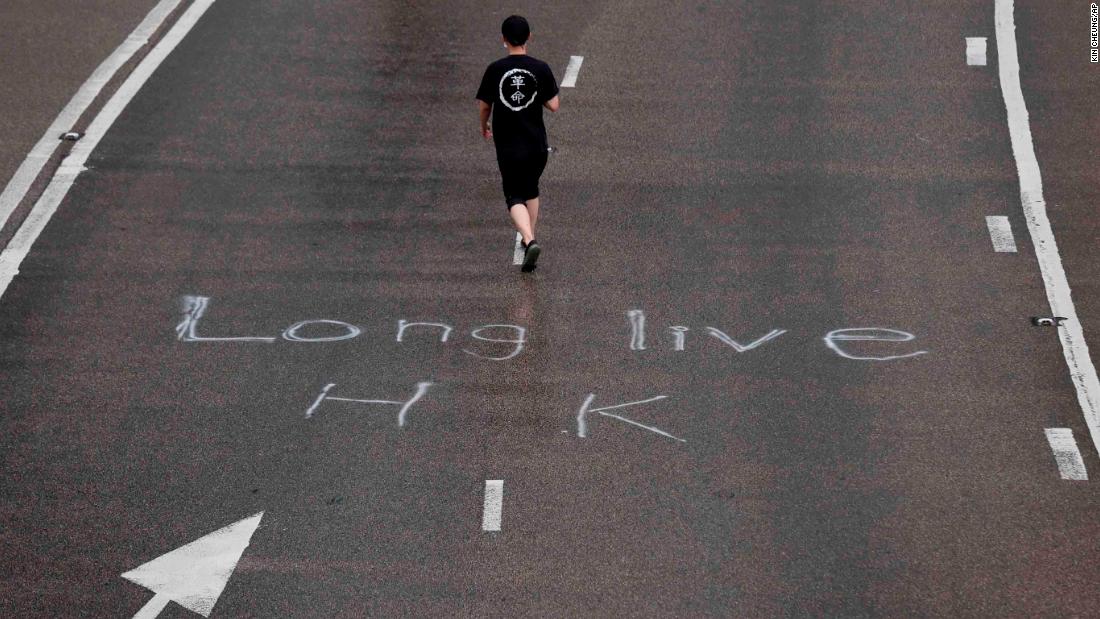
A protester wearing a T-shirt with the word "revolution" walks past an inscription on a road that reads "Long Live HK."

Police detain protesters near the government headquarters in Hong Kong on July 1.

An overhead view shows thousands of protesters marching through a Hong Kong street on Sunday, June 16.

A protester returns a tear-gas canister fired by police during clashes outside the government headquarters in Hong Kong on Wednesday, June 12.

Rubber bullets, pepper spray and hand-thrown tear gas were used to push back protesters who had occupied the city's main thoroughfare and other roads near the government headquarters on June 12, Hong Kong Police Commissioner Steven Lo Wai-chung said.

Protesters run after police fired tear gas on June 12.

A police officer reacts to an umbrella that was thrown near the Legislative Council building on June 12.

Police officers use a water cannon on a protester near the government headquarters.

A protester reacts as she is grabbed by police on June 12.

Protesters face off with police during the rally on June 12.

A protester rests during the demonstration on June 12. Protesters began arriving the night before.
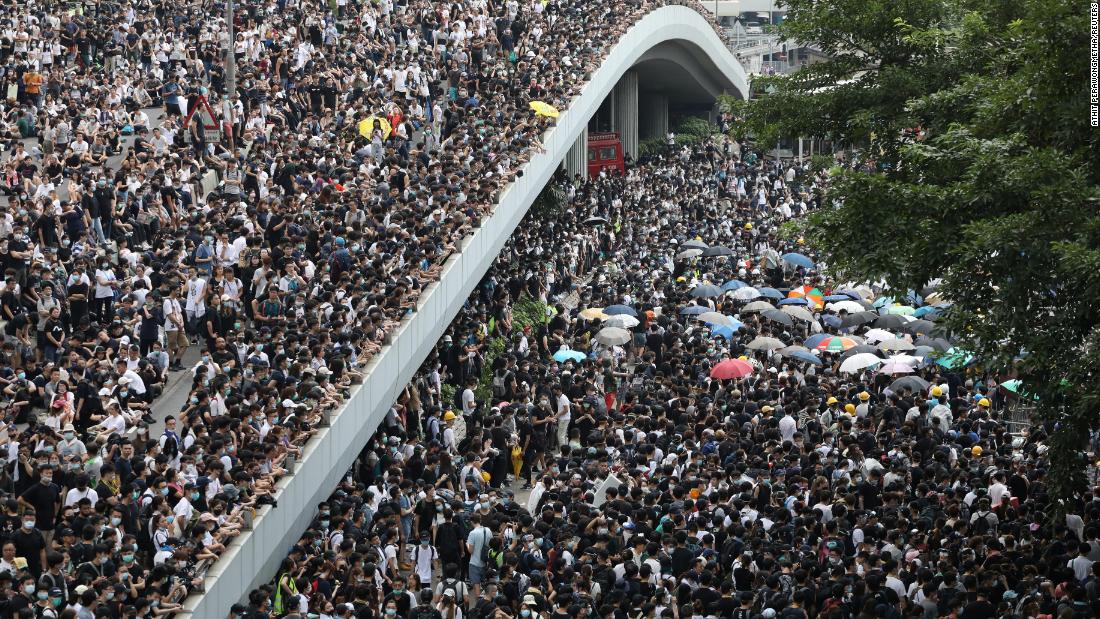
By the morning of June 12, tens of thousands of mainly young people had arrived in the area, blocking streets and bringing central Hong Kong to a standstill.

Protesters block major roads near the Legislative Council and government headquarters. Hundreds of businesses, parents and teachers called for a boycott of work and school to show their opposition to the extradition bill.

A demonstrator holds a sign during the June 12 rally.
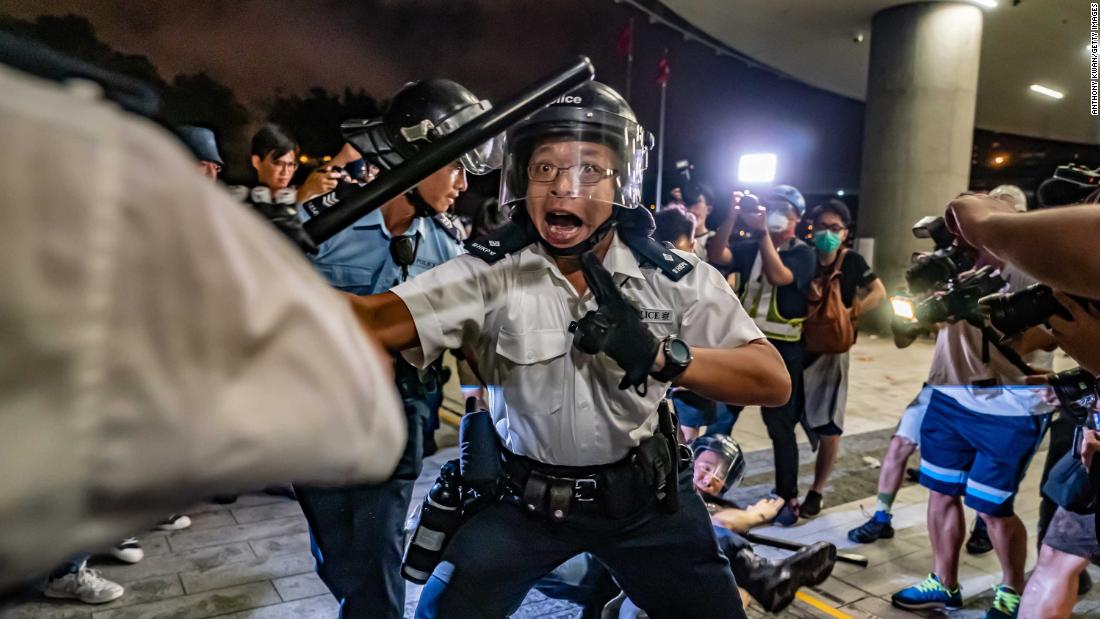
Police officers charge toward protesters during clashes on Monday, June 10. It was a continuation of protests that started the day before.

A police camera films the rally on Sunday, June 9.

Protesters hold pictures of Hong Kong Chief Executive Carrie Lam on June 9.
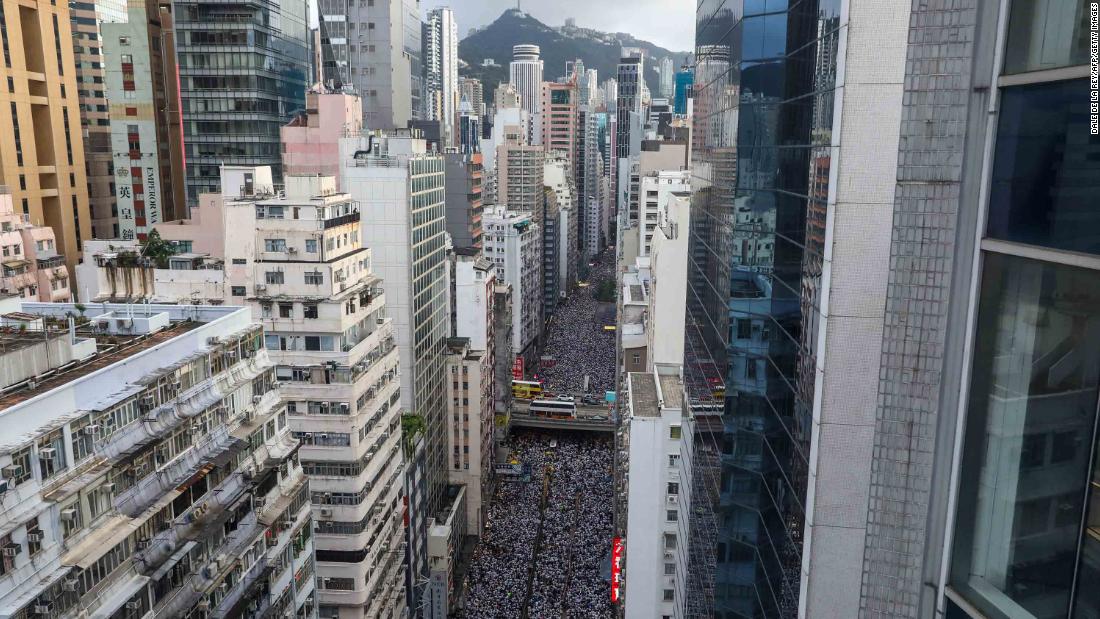
Protesters on June 9 waved placards and wore white -- the designated color of the rally. "Hong Kong, never give up!" some chanted.

A crowd fills a Hong Kong street on June 9.
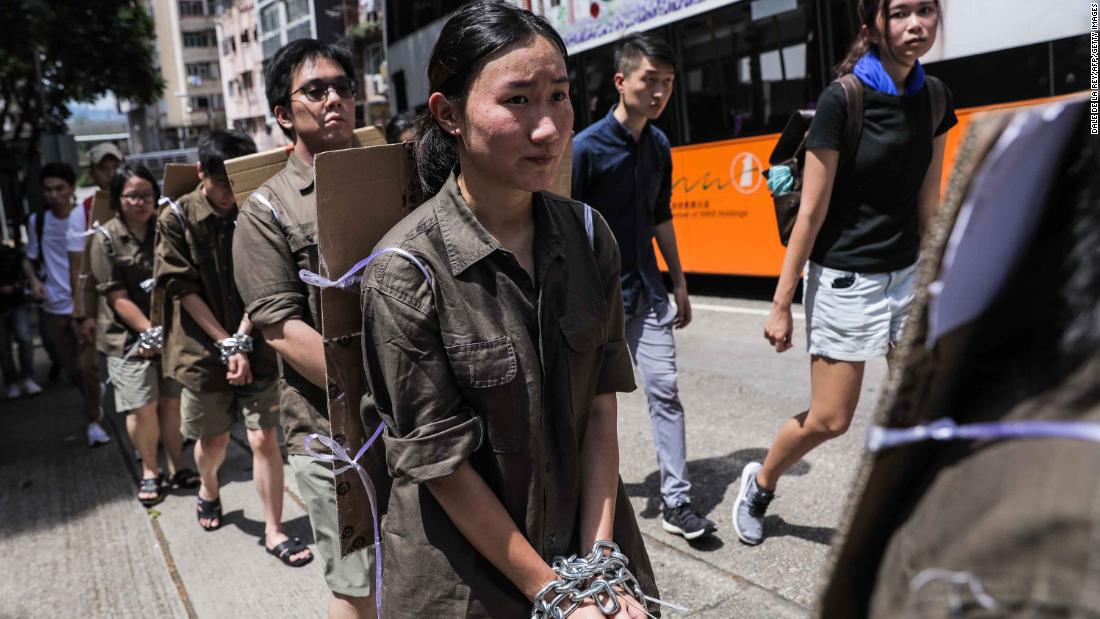
Students wear chains during a demonstration on Saturday, June 8.
Initially, almost all mention of the protests was censored, as is usual for anti-government action anywhere in China. Stories that did appear played up local support for the now-shelved extradition law, and framed opposition to it as a minority.
As the movement evolved, however, so too did Chinese state media coverage.
Violent clashes between police and protesters, beginning on June 12 when crowds effectively shut down the city's legislature and police cleared them with heavy force, were given sudden prominence and distributed widely.
A one one-sided narrative was constructed in which protesters, now labeled "violent mobs," were solely responsible for the escalating conflict. This was soon joined by allegations -- including from senior Chinese officials -- that Washington and other foreign governments were "meddling" in the protests and using them as a vehicle to attack China.
As the protests continued, violent mobs became "criminals" and "separatists," pursuing not greater democracy or an investigation into police violence, as they have demanded publicly, but Hong Kong independence.
On Monday, this gradual rhetorical escalation reached a new stage, with Yang Guang, a spokesman for the Hong Kong and Macao Affairs Office, China's top body in charge of affairs in the city, saying the protests showed "signs of terrorism."
"Hong Kong's radical demonstrators have repeatedly attacked police officers with extremely dangerous tools," he said. "They have already constituted serious violent crimes and have begun to show signs of terrorism. This is a gross violation of the rule of law and social order in Hong Kong, which is endangering the lives and safety for Hong Kong citizens."
In video: Chinese armed police armored vehicle fleet is prepared for a drill in Shenzhen, S China's Guangdong province. pic.twitter.com/bU4IxhaM0s
— People's Daily, China (@PDChina) August 12, 2019
On the same day, amid images of chaos coming out of Hong Kong's paralyzed international airport, Chinese state media broadcast images of the People's Armed Police (PAP) conducting drills in the neighboring mainland Chinese city of Shenzhen, in an apparent message to a domestic audience that the force stood poised to assist in crushed the protests. Some videos included subtitles highlighting relevant Chinese law that the PAP, which is under the direct control of the Central Military Commission headed by President Xi Jinping, can be used to "handle riots, unrest, severe violent criminal activities, terrorist attacks and other public safety incidents."

Wong: US should 'support Hong Kong democratization' 10:22
Worrying signal
Lev Nachman, an expert in social movements in Hong Kong and Taiwan at the University of California, Irvine, said that while Yang's use of the caveat "signs of terrorism," rather than outright saying protesters were terrorists, was something of a silver lining, it suggested "harsh repression by the regime is now no longer off the table, especially if protests continue."
"Evoking terrorism is rhetorical groundwork for escalation, it gives the Communist Party room to continue down this loaded line of 'terrorism' discourse that has the potential to justify whatever violence they deem necessary to stop whatever the 'terrorist' threat is," he said. "It almost feels like a threat from Yang Guang to the protesters that they are approaching a level of disruption that the (Party) no longer finds acceptable."
Under Hong Kong's de facto constitution, the government can request the assistance of China's People's Liberation Army (PLA) garrison in the city for the "maintenance of public order." However, experts agree that the deployment of the military to the streets of Hong Kong could massively backfire on the government, leading to comparisons to the Tiananmen Square crackdown of 1989 and potentially crashing the economy.
For its part, the Hong Kong government seemed to downplay China's descriptions of the protests, with Senior Superintendent Steve Li saying "based on the current situation, we will handle it as violent protest."
Previously, local officials have also distanced themselves from Chinese propaganda about foreign forces controlling the protests. A senior Hong Kong government official told CNN they had "no evidence" of overseas interference, and pointed to local concerns as the chief driver of the protests.
Chinese state media, on the other hand, took the terrorism line and ran with it. State broadcaster CCTV accused protesters of attempting to murder police and said the unrest "obviously has the color of terrorism" which required the government to "resolutely crack down."

Police and demonstrators clash during march 02:33
Official news agency Xinhua played up comments by an official in Hong Kong that the city risked sliding "into a bottomless abyss if the terror atrocities are allowed to continue," while an editorial in the nationalist tabloid Global Times said "raging mobs" must be "receiving support through nefarious political gain or financial stimulation" and were "without any doubt, similar to terrorists."
Yaqiu Wang, a researcher with Human Rights Watch, said the terrorism framing was "extremely concerning."
She pointed to the use of "vaguely and broadly defined 'terrorism' charges" to justify widespread repression in Xinjiang, a region in northwest China with a large Muslim minority. Beijing has been accused of running a huge network of detention camps in Xinjiang, with potentially millions of mostly Uyghur Muslims being processed for "re-education."
Uyghurs have been the chief target of the "terrorist" designation in China, part of a general othering of the non-ethnically Chinese minority which has gone hand in hand with greater repression in the region. Suggesting that Hong Kongers, almost all of whom are Han Chinese, are also terrorists would be a major shift in how Beijing views the city and its relationship to the Chinese metropole.
The World Uyghur Congress, a Germany-based NGO highly critical of China, also said it was "tremendously concerning" that the government was using the term terrorism with regard to Hong Kong.
However, Wang noted that "the contexts of Hong Kong and Xinjiang are vastly different, to launch a 'Xinjiang-style' crackdown in Hong Kong would be hard to do and very costly to Beijing, for reasons such as Hong Kong is a major financial center in Asia and the residents are very digitally connected."
"The extraordinary activism demonstrated by Hong Kong people in the past three months has shown their resolve and competence in defending their freedoms and rights," she said. "Beijing should take note of that."
This story has been updated.
CNN's Steven Jiang contributed reporting from Beijing.

Post a Comment